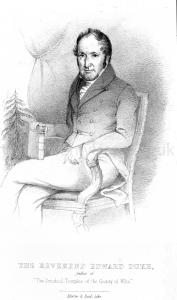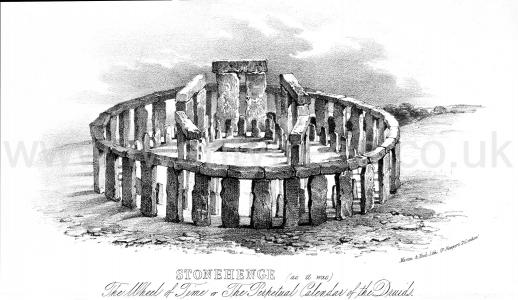Biography of Reverend Edward Duke 1779-1852
Reverend Edward Duke (age 23) was educated at Magdalen Hall, Oxford University being awarded BA in 1803 and MA in 1807.
On 24 Sep 1779 Reverend Edward Duke was born to Edward Duke of Lake House and Fanny Field at Lake House, Wilsford [Map].
In 1805 [his father] Edward Duke of Lake House died.
In 1813 Reverend Edward Duke (age 33) and Harriet Hinxman were married. They had four sons and four daughters.
Druidical Temples in the County of Wilts. The Druidical Temples Of The County Of Wilts. By The Rev. E. Duke (age 66), M.A. F.A.S. F.L.S. And Member Of The Archeological Institute Of Great Britain And Ireland. "Veterum volvens monumenta virorum." — Virgil. London: John Russell Smith, 4, Old Compton Street, Soho Square; Salisbury: W. B. Brodie and Co. MDCCCXLVI.


Stonehenge Edward Duke. Letter Relative to Stonehenge by the Reverend Edward Duke (age 71). 1851.
To The Secretary Of The Archaeolological Institute.
My dear Sir,
From the time that I heard of the archæological meeting in this neighbourhood, it had been my wish and hope to have offered to its members a paper on Stonehenge, to which I have given my attention for some years. As the time draws near, however, I find myself compelled, although reluctantly, to decline the more elaborate essay I had purposed. My health, broken by repeated and very severe attacks of illness, will not allow the application of mind to a subject for any length of time without injury.
If, however, you will permit me to do so, I shall venture to offer to your consideration, and submit to your judgment, some points which would have found a place in the contemplated essay, had I been able to complete it.
I think you may be aware that, about three years since, I put through the press a small volume bearing the title of the Druidical Temples of Wilts. In that work Stonehenge was considered as forming part of a planetarium, in connexion with Abury, in the more northern part of the county, and with a series of remains to be traced on the face of the intervening country, the gigantic proportions of which were such that its meridional line was extended no less than two-and-thirty miles. It was while my mind was engaged on this subject, subsequently however to the publication of the book, that the theory of the construction of Stonehenge was gradually presented to it, both with a more distinct outline and in fuller detail. I have not, indeed, found occasion to reject or displace any of the opinions I have formerly expressed: my later occupation has been to add to, and complete my view on this portion of my former subject.
I now, therefore, separate Stonehenge from Abury and the other sacred stations with which, for certain purposes, it was conjoined, and proceed to regard it (as, of course, it may be regarded) in the light of a temple standing alone, entire and perfect in itself, totus in se, teres, atque rotundus.
In approaching Stonehenge, it may be advisable for a stranger, who is making his inspection for the first time, to forbear entering the sacred precincts from that side by which he would naturally arrive on his road from Salisbury ; and to diverge from the path, till he come to the Gnomon, or index-stone, on the north-east side. He will walk from thence beneath the centre arch of the three imposts in front, and so proceed up the temple. In this way, with ordinary attention and intelligence, its plan will become evident at once, which otherwise must appear to the observer involved in a chaotic confusion.
We will suppose our Archaeologist arrived, for the first time in his life, at the outer circle of this venerable monument.
This consisted originally of thirty upright stones, joined together at the top by a continued corona of the same number of imposts: their substance being a silicious grit, permeated here and there with a thin vein of quartz ; and therefore bearing intrinsic evidence that they are Nature's handiwork, and not, as some have supposed — the great Camden among them — from the manufactories of man.
Their height is sixteen feet; their sides shaped into regular parallelograms by the chisel, and their inner surfaces bevelled, from the bottom upwards, for the greater firmness and security of the mass ; a hint which our Norman forefathers did not neglect to observe and follow in the churches which their piety reared in the neighbouring bournes.
These stones, when first set up, were evidently located with great art; externally they must have presented a gentle curve, and internally have shewn a polygon of thirty sides. We have here, then, thirty stones with their thirty intervals, each distinct by itself, and yet all linked together, and united into one, by the one superincumbent and encircling corona. In this, therefore, we behold, in their several and joint characters, the thirty days and thirty nights into which, anciently, each of the twelve months of the year was equally divided, — the perpetual, standing calendar of the Druids for that space of time; or, when multiplied by twelve, their almanac for the year.
A simple arrangement truly, and befitting a simple and unsophisticated people, but not to be denied a higher praise also; for it has been held truly that works of genius are to be known by the most perfect adaptation to their end, combined with the greatest possible simplicity. Of the arrangement of their ecclesiastical year we have, it is true, but little knowledge. Fasts, we may presume, were to them unknown. Of festival days, days of high rejoicing and holy observation, we may not doubt that they had their proper allowance. They were those probably pointed out by nature, or received from earliest primeval tradition — the equinoxes, the solstices, the new moons, and the sabbath-days. Thus, in each monthly revolution, the progress of the month upon any given day would be marked by the stone at which they might then have arrived ; and by this calendar, — for the integrity of which its publicity and the consciences of the priesthood were the vouchers, — the possibility of a national doubt, or of conflicting calculations in any two different parts of the nation, as to precise timet whether in regard to the celebration of sacred feasts or to the fulfilment of civil contracts was averted ; for a reference was always feasible to the great national calendar at Stonehenge, whose fiat would be at once decisive of the doubt or controversy. It was, in fact, the authority of that day, from whose voice there was no appeal.
Proceeding inwards, from the circumference to the centre of the temple, we shall come next to the remains of a circle of smaller stones, of granite, porphyry, &c., concentric with the outer circle. On the number of the stones composing this interior circle much diversity of opinion exists among antiquaries. Upon this question I shall not now enter, but assume that the opinion in which Stukeley and Sir R. C. Hoare concur is the correct one, namely, that it consisted of neither more nor less than forty. I shall take leave, however, to disagree with Sir Richard, and also Mr. Cunnington, as to their decision upon another point. They have advanced an opinion that the larger stones at Stonehenge were erected, in point of time, previously to the smaller ones, which last they think to have been subsequently inserted among them.
On 28 Aug 1852 Reverend Edward Duke (age 72) died at Lake House, Wilsford [Map]. The eldest son, Edward, who had also entered the church, succeeded to the estates.
Father: Edward Duke of Lake House
GrandFather: John Field of islington
Mother: Fanny Field